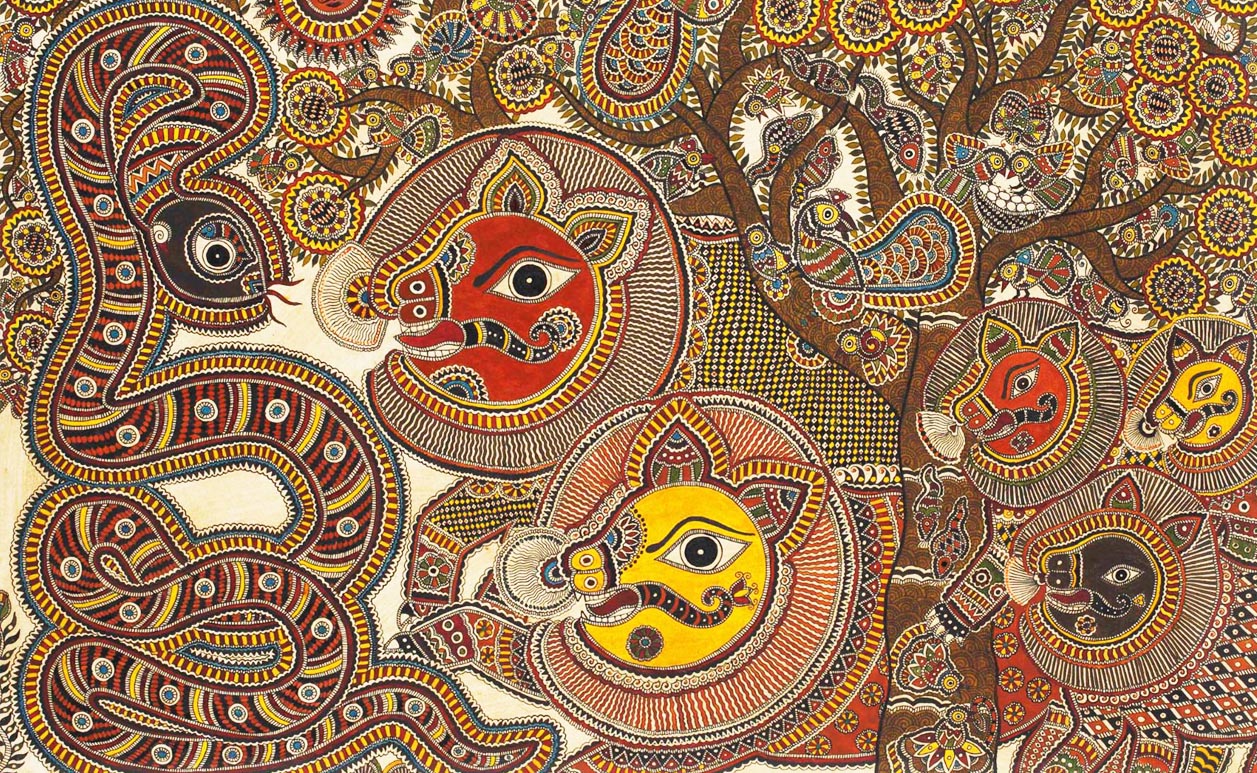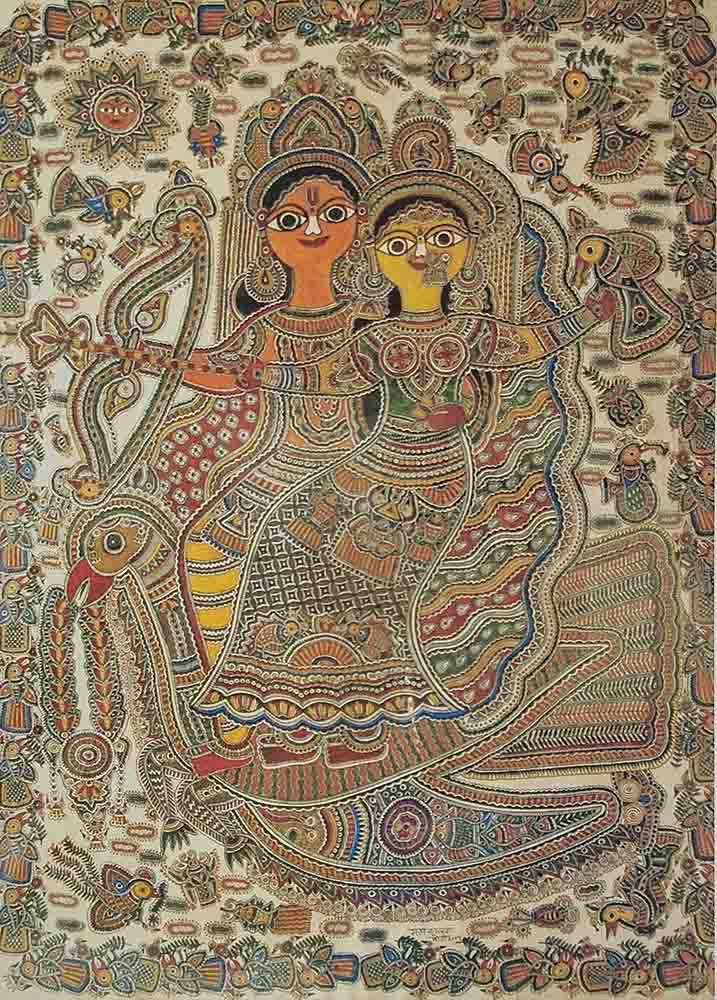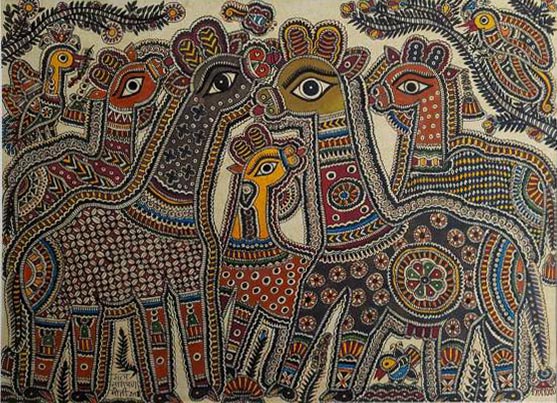Madhubani art

Madhubani art, sometimes called Mithila art, is a painting technique used in the Mithila region of Nepal and India. It is named for the Madhubani area of Bihar, India, the most active center of manufacturing and the place of its inception. Three cities that are most prominent in the history and development of Madhubani art are Jitwarpur, Ranti, and Rasidpur. Female members were generally the ones who practiced the craft. A range of tools, such as their own fingers, twigs, brushes, nib-pens, and matchsticks, are used by artists to make these paintings. The pigments and natural dyes used to make the paint include lampblack and ochre, which are used to create black and reddish brown, respectively.The paintings are distinguished by their striking geometrical designs. Certain events, like births or marriages, and festivals, like Holi, Surya Shasti, Kali Puja, Upanayana, and Durga Puja, have ritual content.
In the past, painting was a technique that was mostly taught by women in the Mithila Region and was passed down from generation to generation. Female members were generally the ones who practiced the craft. A range of tools, such as their own fingers, twigs, brushes, nib-pens, and matchsticks, are used by artists to make these paintings. The pigments and natural dyes used to make the paint include lampblack and ochre, which are used to create black and reddish brown, respectively. In institutions located throughout the Mithila region, it is still practiced and maintained. Madhubani painting has been preserved by a number of important centers, including Kalakriti in Darbhanga, Vaidehi in Benipatti in Madhubani district, and Gram Vikas Parishad in Ranti.
Origin and tradition
Mithila, the birthplace of the Hindu goddess Sita, is where Madhubani paintings were initially produced. Sita's father, King Janak, requested paintings to document special moments on the wedding day of Sita and her spouse, Prince Rama. In the Mithila region of the Indian subcontinent, women from a variety of cultures have historically produced Madhubani paintings, also known as Mithila paintings. The Madhubani district in Bihar's Mithila region is where it first appeared. Another important export destination for these paintings is Madhubani.

Rati Kamdev (the goddess and god of love), Natural dyes on handmade paper, 30 x 22 inches, available on commission basis.
Traditionally, the paintings were created on the floors and walls of huts constructed of newly plastered mud, but they are now also created on canvas, handmade paper, and cloth. The paste formed from powdered rice is used to create Madhubani paintings. Madhubani painting has stayed within a small geographic area, and while the techniques have been passed down through the ages, the subject matter and aesthetics have mostly not changed. As a result, Madhubani paintings are now considered geographical indications, or GIs. Traditionally, Madhubani paintings use colors that come from nature and two-dimensional imagery.Traditional pigments included: rice paste for white, turmeric for yellow ochre, vermilion powder mixed with ground mustard seeds for red, cow dung mixed with lampblack for greenish black, pevdi for lemon yellow, indigo for blue, palash flower for orange, bilva leaf for green, and red clay for indian red. Gum arabic or goat's milk were employed as the binder for the paint; the former was utilized for painting on paper, while the latter was mostly used for painting walls. Additionally, in the 1940s, Calcutta-sourced chemical powder pigment became accessible. The paste formed from powdered rice is used to create Madhubani paintings. Madhubani painting has stayed within a small geographic area, and while the techniques have been passed down through the ages, the subject matter and aesthetics have mostly not changed. As a result, Madhubani paintings are now considered geographical indications, or GIs. Traditionally, Madhubani paintings use colors that come from nature and two-dimensional imagery. Traditional brushes made of wood, rags, and bamboo slivers are being used by artists today.
Symbols
People and their associations with nature, ancient epic situations, and deities are primarily portrayed in Mithila art. Along with scenes from the royal court and social gatherings like weddings, painted scenes also frequently feature natural phenomena like the sun, moon, and religious plants like tulsi. Typically, there is never a blank space in these paintings; instead, the spaces are occupied by depictions of geometric patterns, flowers, animals, and birds. Along with scenes from the royal court and social gatherings like weddings, painted scenes also frequently feature natural phenomena like the sun, moon, and religious plants like tulsi. A mixture of lime, glue, and synthetic enamel was used by local painters to paint trees in an effort to discourage deforestation.

Giraffe family, Natural dyes on handmade paper, 11 x 15 inches.
Style
Mithila art has five distinctive styles:
- Bharni
- Katchni
- Tantrik
- Godna
- Kohbar
In the 1960s, Brahmin women in India and Nepal produced the majority of Madhubani art in the Bharni and Tantrik styles, which were characterized by religious themes and representations of gods and goddesses. Other castes of artists used symbolism, local myths such as the tale of Raja Shailesh, and aspects of their everyday lives in their paintings. Caste boundaries no longer apply to Madhubani art, which has become a universal art style in modern times. All five forms of art are now freely practiced by artists, and Mithila art has become well-known worldwide. Other castes of artists used symbolism, local myths such as the tale of Raja Shailesh, and aspects of their everyday lives in their paintings. Caste boundaries no longer apply to Madhubani art, which has become a universal art style in modern times. Traditionally, a bride and husband spend their first night together in a Mithila bridal chamber, where the wall is painted in the Khobar style, also called puren.
Contributions
To help women in the poor Mithila region find new sources of income, Madhubani painters started painting on canvas and paper in the 1960s.
In 2012, when the Indian state of Bihar was experiencing widespread deforestation, the Madhubani painting tradition was crucial to conservation efforts. The effort to stop local trees in Bihar from being felled for construction and road expansion was spearheaded by the non-governmental organization Gram Vikas Parishad. A mixture of lime, glue, and synthetic enamel was used by local painters to paint trees in an effort to discourage deforestation. Gods and other religious and spiritual images found in paintings included Radha-Krishna, Rama-Sita, and scenes from the Ramayana, Mahabharata, and other epics.

Doli (Bride in a palanquin), Natural dyes on handmade paper, 11 x 30 inches, available on commission basis.
In 1969, the Bihar government awarded Sita Devi the State Prize, thereby recognizing Madhubani painting. Additionally, the National Award was given to Mamta Devi from the village of Jitwarpur. The Padma Shri was awarded to Jagdamba Devi of Bhajparaul, Madhubani, in 1975, while Sita Devi of Jitwarpur village, which is close to Madhubani, received the National Award. Both Satya Narayan Lal Karn, the foster son of Jagdamba Devi, and his wife Moti Karn are highly acclaimed Mithila artists, and they shared the 2003 National Award. In 1981, the Padma Shri was bestowed upon Sita Devi. In addition, Sita Devi received the Shilp Guru award in 2006 and the Bihar Ratna award in 1984.
Padma Shri presented Ganga Devi with an award in 1984. In 2011, Mahasundari Devi was bestowed the Padma Shri. Other recipients of the National Award included Baua Devi, Yamuna Devi, Shanti Devi, Chano Devi, Bindeshwari Devi, Chandrakala Devi, Shashi Kala Devi, Leela Devi, Godavari Dutta, Asha Jha Tira Devi, and Bharti Dayal. In 2003, the National Award was given to Shree Chandra Bhushan Lal Das of Rasidpur, Madhubani. In 2009, Ambika Devi (Rasidpur, Madhubani) was granted the National Award. In 2013, the national prize was jointly given to Smt. Manisha Jha from Raghopur Balat, Madhubani; Smt. Asha Jha from Kathalwadi Belabhor, Dharbhanga; and Shree. Devendra Kumar Jha from Jitwarpur, Madhubani. For her artistic accomplishments, Madhubani artist Dulari Devi was awarded the Padma Shri in 2020.
Join our classes to enhance & improve your memory skills and let your child unlock the power to retain information from every moment of his/her life!
